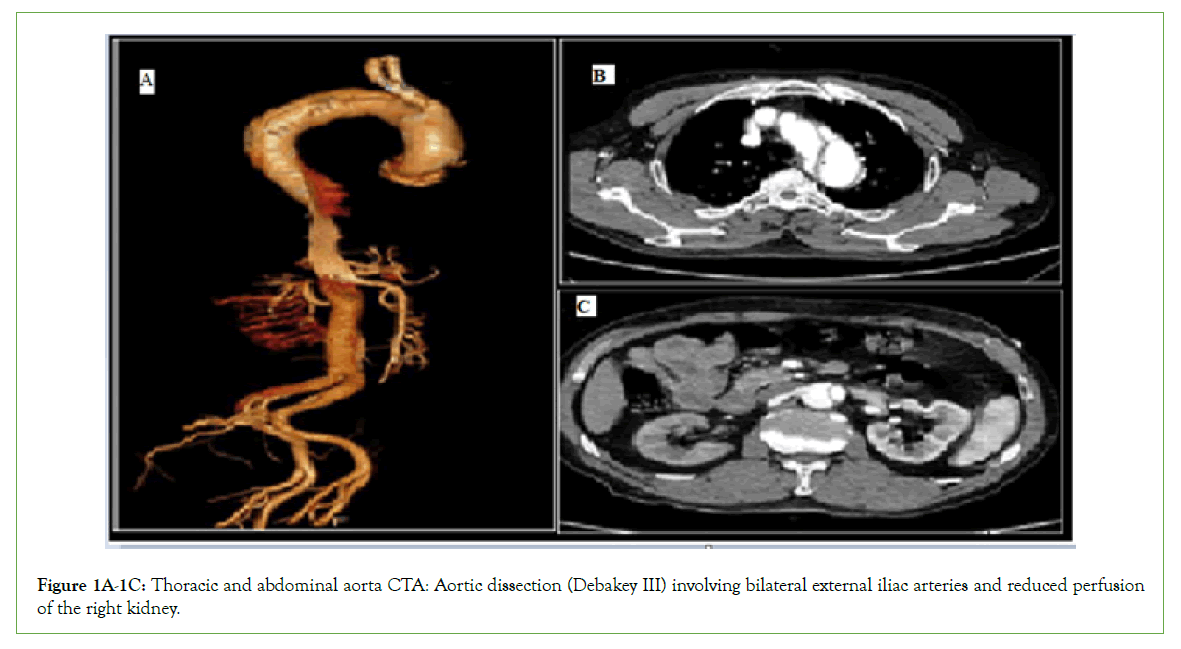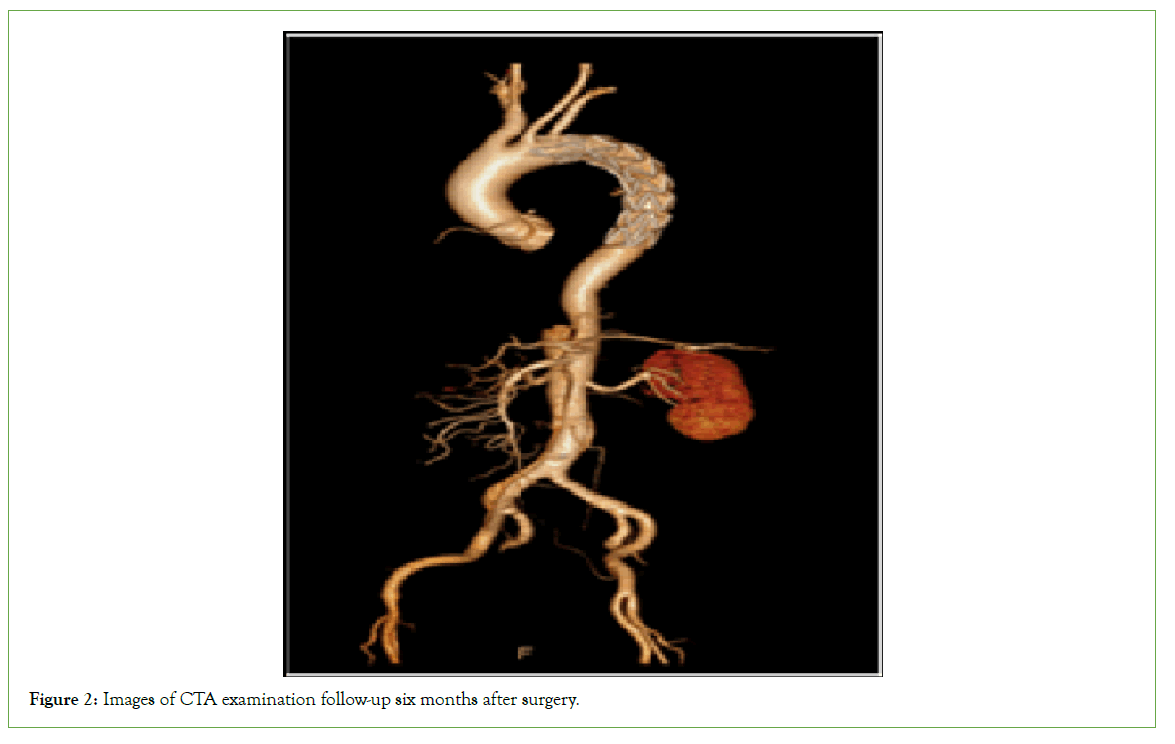Indexed In
- Open J Gate
- Academic Keys
- RefSeek
- Hamdard University
- EBSCO A-Z
- OCLC- WorldCat
- Publons
- Euro Pub
- Google Scholar
- SHERPA ROMEO
Useful Links
Share This Page
Journal Flyer

Open Access Journals
- Agri and Aquaculture
- Biochemistry
- Bioinformatics & Systems Biology
- Business & Management
- Chemistry
- Clinical Sciences
- Engineering
- Food & Nutrition
- General Science
- Genetics & Molecular Biology
- Immunology & Microbiology
- Medical Sciences
- Neuroscience & Psychology
- Nursing & Health Care
- Pharmaceutical Sciences
Case Report - (2023) Volume 0, Issue 0
Chest Tightness as the Only Presenting Symptom of Atypical Aortic Dissection: A Case Report
Zhang Peng1* and Zheng Hongyu22Department of Anesthesiology, Xiangyang Central Hospital, Affiliated Hospital of Hubei University of Arts and Science, Xiangyang, China
Received: 17-Jul-2023, Manuscript No. JVMS-23-22205; Editor assigned: 20-Jul-2023, Pre QC No. JVMS-23-22205 (PQ); Reviewed: 04-Aug-2023, QC No. JVMS-23-22205; Revised: 11-Aug-2023, Manuscript No. JVMS-23-22205 (R); Published: 21-Aug-2023, DOI: 10.35248/2329-6925.23.S17.521
Abstract
Introduction: Chest pain is a frequent reason for patients with Aortic Dissection (AD) visiting hospital. Most of their patients, their clinical history was much shorter, patients with long-term chest tightness are rather rare. In the retrospective study, the diagnosis and treatment of an atypical AD case with prolonged intermittent chest tightness involving bilateral external iliac artery were referred.
Case presentation: In this case, the patient only had symptoms of chest tightness and was not diagnosed as AD in time due to the inexperience of the receiving doctor. However, the patient’s chest CT timely considered the possibility of AD, and confirmed the diagnosis of AD after completing CTA, and carried out surgical treatment in time
Discussion: Atypical AD in clinic is relatively rare, clinicians to the disease, for no chest pain symptoms and with chronic hypertension, clinicians should ask for details of the history, to rule out other possible disease, should not ignore the existence of AD possible, should have more communication with image doctor communication, complete the CT Angiography (CTA) inspection when necessary, clear AD diagnosis as early as possible.
Conclusion: AD is a very serious cardiovascular emergency; Clinicians should raise awareness of AD, especially of atypical AD, to promote its early diagnosis.
Keywords
Aortic dissection; Chest tightness; Hypertension; Rare diseases; Blood pressure
Introduction
Chest pain is a frequent reason for Patients with Aortic Dissection (AD) visiting hospital. Most of their patients, their clinical history was much shorter, Patients with long-term chest tightness are rather rare. In the retrospective study, the diagnosis and treatment of an atypical AD case with prolonged intermittent chest tightness involving bilateral external iliac artery were referred, we reported this case, analyzing its clinical characteristics and causes, in order to improve the clinician’s awareness of this disease, to ensure early detection and prompt treatment.
Case Presentation
Male patient, 66 years old. He was admitted to the hospital for “intermittent chest tightness for 1 year and aggravated for 1 week”. The patient had intermittent chest tightness without obvious inducement 1 year ago, which could be relieved during rest, and the symptom worsened 1 week ago. He had no obvious chest pain, dyspnea, no abdominal pain and diarrhea, in order to clarify the diagnosis of the disease came to the hospital. Prior history of hypertension, the highest blood pressure is 190/? mm Hg, self- reported blood pressure was well controlled. From August 17, 2021 to the emergency department of our hospital.
Physical examination
T 36.8 C, P 78 times/min, R 17 times/min, BP 153/110 mmHg. The breathing in both lungs was thick and not dry and wet rales. The apical beat was located 0.5 cm lateral to the left intercostal clavicle midline, and the heart’s border of relative dullness expands in the lower left, the heart beating rhythm is neat, Bp 78 times/min, A2 hyperactivity. Inspection found that NT-pro BNP 489.9 pg/mL. Color doppler echocardiography indicated that left ventricular hypertrophy and left ventricular ejection fraction was 55%. No obvious abnormality was found in blood routine examination, blood biochemistry, liver and kidney function, myocardial infarction, coagulation function and electrocardiogram. Chest CT showed no obvious lesions in both lungs, uneven density of aorta, abnormal density shadow in crescent shape, and aortic dissection was considered. Immediate aortic CTA examination revealed aortic dissection (type Debakey III) involving bilateral external iliacobvious abnormality was found in blood routine examination, blood biochemistry, liver and kidney function, myocardial infarction, coagulation function and electrocardiogram. Chest CT showed no obvious lesions in both lungs, uneven density of aorta, abnormal density shadow in crescent shape, and aortic dissection was considered. Immediate aortic CTA examination revealed aortic dissection (type Debakey III) involving bilateral external iliac arteries (Figures 1A-1C). Based on the patient’s history and clinical data, aorta dissection (Standford B) and hypertension grade 3 (extremely high risk group) were diagnosed (Figure 2). Then the patient was treated with endovascular aortic stent isolation in department of cardiothoracic surgery. The patient’s symptoms of chest tightness were improved and the patient was discharged after good recovery.
Figure 1A-1C: Thoracic and abdominal aorta CTA: Aortic dissection (Debakey III) involving bilateral external iliac arteries and reduced perfusion of the right kidney.
Figure 2: Images of CTA examination follow-up six months after surgery.
Results and Discussion
AD is a very serious cardiovascular emergency, with an annual prevalence rate of (5-30)/1 million, mainly in middle-aged and elderly men aged 40-70 years [1]. Most AD is characterized by sudden lacerating pain in the chest as a typical clinical manifestation [2]. For these patients, it is not easy to be misdiagnosed clinically, and most patients can receive timely and effective treatment. However, there are still a small number of patients presenting with atypical clinical manifestations such as chest tightness, hemoptysis, renal failure, abdominal distention, numbness and weakness of lower limbs [3-7]. The understanding of these atypical AD patients’ needs to be improved to promote early clinical diagnosis and treatment of AD.
In this case, chest tightness was the main symptom. Although the patient’s medical history was as long as one year, the patient did not have typical chest lacerating pain and chest tightness appeared intermittently and could be relieved by rest. Therefore, the patient did not care about the disease condition. After the patient was admitted to our hospital, the first physician tended to have coronary heart disease and pulmonary lesions combined with the patient’s symptoms, and failed to timely consider aortic dissection. Later, the patient’s chest CT accidentally found an uneven crescent density of the aorta. Considering the possibility of dissection, further aortic CT vascular imaging CTA confirmed the aortic dissection, with distal involvement of the bilateral external iliac artery.
In recent years, it has been reported in relevant literature that 20% of patients with atypical aortic dissection have no chest pain symptoms, and the proportion of patients without any pain symptoms is as high as 6%, in Our country, Standford type B aortic dissection is the most common, accounting for about 60% [2,8]. Due to the low possibility of descending aortic rupture, Standford type B AD patients have a lower mortality rate. Analysis of the reasons for the atypical symptoms of the patient in this case may be slow aortic intima tear, long-term regular oral antihypertensive drugs, small blood pressure fluctuation, after the formation of aortic pseudolumen, pseudolumen occlusion, the blood flow status of the true lumen is relatively stable, so the patient’s medical history is as long as one year, but only intermittent chest tightness, relatively stable condition.
Conclusion
Aortic dissection is extremely dangerous and often progresses faster with increased blood pressure. Once the dissection ruptures, the patient’s life can be rapidly endangered. Abnormal blood supply to organs caused by long-term dissection tears can lead to impaired organ functions. For example, in this case, blood supply to the right kidney was reduced, but no obvious abnormality was found in renal function examination due to the compensation of left renal function. Therefore, early diagnosis and treatment plays a crucial role in improving the clinical survival rate and reducing complications of AD. Based on the diagnosis and treatment of this patient, the experience is as follows. Clinicians recognize the complex and diverse manifestations of AD. For AD patients without clinical chest pain, the possibility of AD should be considered after the common diseases considered at the initial diagnosis are excluded, especially for the patients with a history of chronic hypertension, a high degree of vigilance should be maintained, the history should be inquired in detail, the physical examination should be carried out comprehensively and carefully, and every symptom, sign and auxiliary examination results should be carefully analyzed. For the clinical manifestations that are difficult to be explained by chest and abdominal CT, it is necessary to actively communicate with radiologists and improve CTA examination when necessary to reduce the missed diagnosis and wrong treatment of AD.
References
- Maddu KK, Shuaib W, Telleria J, Johnson JO, Khosa F. Nontraumatic acute aortic emergencies: Part 1, acute aortic syndrome. AJR Am J Roentgenol. 2014;202(3):656-665.
[Crossref] [Google Scholar] [Pub Med]
- MacGillivray TE, Gleason TG, Patel HJ, Aldea GS, Bavaria JE, Beaver TM, et al. The society of thoracic surgeons/american association for thoracic surgery clinical practice guidelines on the management of type B aortic dissection. Ann Thorac Surg. 2022;163(4):1231-1249.
[Crossref] [Google Scholar] [Pub Med]
- Wu J, Xie E, Qiu J, Huang Y, Jiang W, Zafar MA, et al. Subacute/chronic type a aortic dissection: A retrospective cohort study. Eur J Cardiothorac Surg. 2020;57(2):388-396.
[Crossref] [Google Scholar] [Pub Med]
- Minegishi S, Goto H, Yamabi H, Imanaka K. Hemoptysis a rare complication of acute aortic dissection. Int Heart J. 2018;59(5):1146-1148.
[Crossref] [Google Scholar] [Pub Med]
- Leake S, Sandhu HK, Safi HJ, Estrera AL, Charlton-Ouw KM. Predictive and prognostic risk factors of renal failure in acute aortic dissection. J Vasc Surg. 2017;100(41):26-27.
- Vaidyanathan S, Hughes PL, Oo T, Soni BM. Recurrent autonomic dysreflexia due to chronic aortic dissection in an adult male with cervical spinal cord injury. Scientific World Journal. 2008;8:604-610.
[Crossref] [Google Scholar] [Pub Med]
- Theologou T, Harky A, Shaw M, Eltyeb H, Elbakbak W, Snosi M, et al. Management of lower limb ischemia during operative repair of acute type A aortic dissection by distal crossover grafts: A case series. Braz J Cardiovasc Surg. 2020;35:607-613.
[Crossref] [Google Scholar] [Pub Med]
- Alter SM, Eskin B, Allegra JR. Diagnosis of aortic dissection in emergency department patients is rare. West J Emerg Med. 2015;16(5):629 -631.
[Crossref] [Google Scholar] [Pub Med]
Citation: Peng Z, Hongyu Z (2023) Chest Tightness as the Only Presenting Symptom of Atypical Aortic Dissection: A Case Report. J Vasc Surg. S17:521
Copyright: © 2023 Peng Z, et al. This is an open-access article distributed under the terms of the Creative Commons Attribution License, which permits unrestricted use, distribution, and reproduction in any medium, provided the original author and source are credited.



